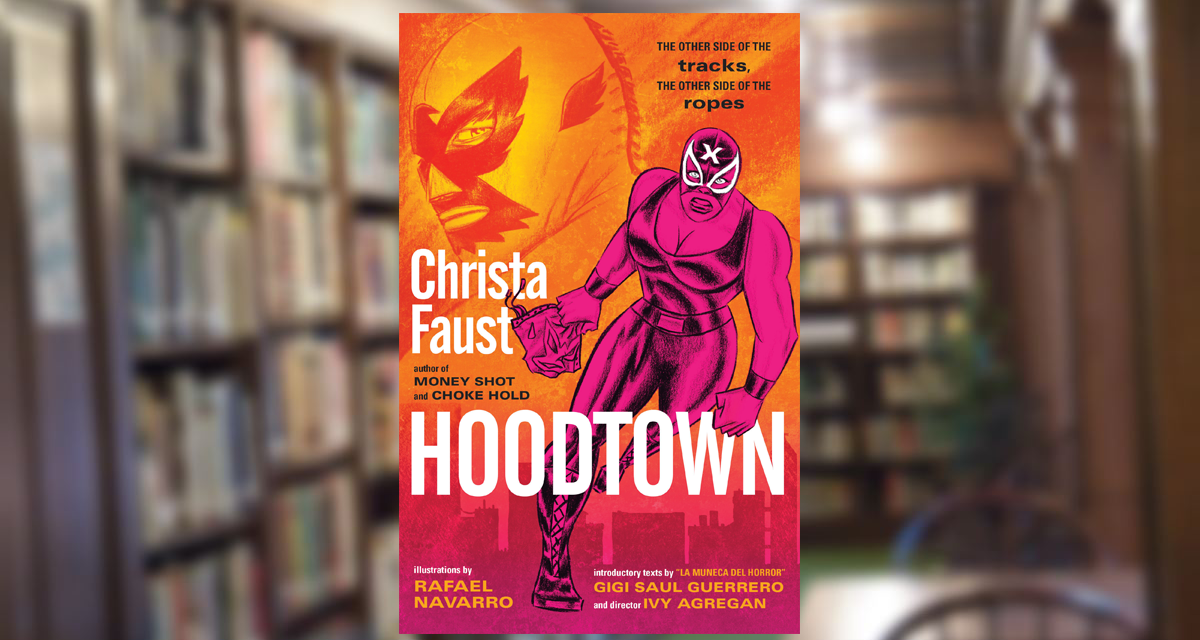Christa Faust initially released her novel, Hoodtown, in 2004. But if you missed it the first time around, fear not! The book is now back in print in a deluxe edition published by From Parts Unknown. Faust cleverly and creatively explores the heavy themes of racism, class and power in a fictionalized setting where the characters are either “hoods” (always clad in a lucha libre mask and I mean always) or “skins” (no mask). Hoodtown is a dark, tough and gritty “ghetto of masked wrestlers” and when a killer starts targeting Hoodtown’s prostitutes and committing the ultimate degradation of leaving their faces unmasked after their murder, it’s up to X, a former luchadora (female wrestler in Mexican pro wrestling) to do something about it. Hoodtown is hands down one of the most unique novels this reader has ever read. It’s definitely an eccentric book that is difficult to categorize, but I regard this trait as a compliment rather than a deterrent. The same can be said for its author, who took the time to have an email chat with SlamWrestling.net about her most extraordinary life experiences and prose.
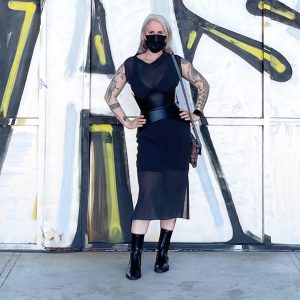
Christa Faust.
Slam: Hi Christa! Where are you originally from and where do you currently reside?
Christa Faust: Born and raised in NYC. I lived in a divorced parent split between Hell’s Kitchen and the Bronx. I’m currently living as an expat in the weird and wonderful foreign land of Los Angeles.
Slam: Your brief about the author section in the back of your book is fascinating. You are of course an author of novels, comics and graphic novels, film novelizations and short stories…
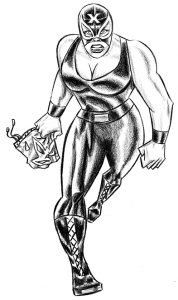
Caption from the book: The new illustration (of X) by Rafael Navarro exclusive to this second edition (of Hoodtown).
Faust: That’s right. I’m all about storytelling in any and all forms and love stretching my range.
Slam: In addition, can you tell me about working in the Times Square peep booths? How did that come about and how long did you do this?
Faust: Believe it or not, I answered a newspaper ad, just like you would for any other kind of job back then. I worked in the booths from around 1987 to ’90. For kids who don’t know what a peep booth is, it’s basically a live cam show. The performer is on one side of the glass, the viewer on the other, and they talk on big, clunky telephone receivers. Many of the most interesting stories from that era are contained in my semi-autobiographical graphic novel, Peepland, coauthored with Gary Phillips.
While I was working there, I noticed that the majority of clients who came to see me wanted to be dominated, humiliated or ignored. I give off that “Big Domme (dominatrix) Energy” naturally, before I even knew what that was. I had a friend who was working in a private dungeon doing BDSM (Bondage and Discipline, Dominance and Submission, Sadochism and Masochism) sessions, and she suggested that I join her. The pay was better than the peep booths and it was way more fun! I was already engaging in kink play in my private life at that time and (this) seemed like a no-brainer way for me to make a better living.
This was also the time in my life where I really started writing regularly and seriously. I had been keeping journals and making up stories ever since I was a little kid but I found that engaging in the creative and collaborative nature of BDSM role play inspired me on this deep, primal level. I sold my first short story during this time and started working on my first novel.
When I first moved to Los Angeles in 1992, I started branching out into the adult film business. I was still doing private sessions as a pro Domme but I also starred in fetish oriented videos and still shoots. From there it was an easy transition to working behind the camera, which I loved. I rigged for bondage videos (meaning tying up models or other performers with elaborate knots off camera and then getting out of the way) and shot, directed and edited all kinds of adult content, both fetish-oriented and vanilla. By far my favorite video project was the campy vintage-style Dita in Distress bondage serial adventure starring Dita Von Teese. That was a wild ride, a true labor of love and also the project over which I had the most creative control.
Slam: What would you like people to know about these professions or maybe a better way of asking is what do you feel are the most common misconceptions about them?
Faust: The porn industry gets a bad rep from ignorant people who have only ever viewed it from the outside, but the performers are way more talented and cerebral than they realize. It’s yet another underestimated and misunderstood extreme physical profession that gets punched down on, not unlike pro wrestling. If there is a single dominant theme running through all my work, it’s this exploration of marginalized people who entertain others with their bodies. That includes porn stars, fighters, wrestlers, and in the case of my current work in progress, rodeo roughies.
Slam: Do you work as an author full-time or do you have other employment?
Faust: I still pick up supplemental income from editing adult video. I stopped seeing BDSM clients in person during the pandemic. Mostly I just write.
Slam: Are you a wrestling fan?
Faust: I’d say I’m more of a lucha libre and joshi (Japanese female pro wrestling) fan than American pro wrestling.
Slam: Outside of your writing, have you had any involvement/training in wrestling?
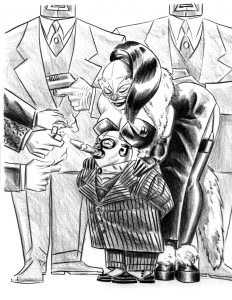
Hoodtown’s El Jefe. Caption from the book: The 1990s, and into the first part of the 2000s was a golden age for “mini” masked superstars in lucha libre. Mexico didn’t invent the motion of what for decades was referred to as “midget wrestling” but what was perfected there was the idea of a little person embodying a miniature version of an established masked star. The athletic skill and story-telling ability of these “Mini Superestrellas” often surpassed that of their full-height counterparts and eventually led to minis developing their own unique characters. El Jefe was certainly a product of himself and no one’s miniature version… Illustration by Rafael Navarro.
Faust: Any time I write about something I don’t do, I like to spend as much time as possible with the people who do it. Being a good listener is the most important skill a writer can have. I traveled through Mexico with a group of local SoCal workers and learned some of the basics to help me understand the business on a deeper level. I did the same when I was working on my novel Choke Hold, which is about MMA (mixed martial arts) fighters. I took some classes with Gokor Chivichyan (in which I regularly got my ass handed to me by 12 year olds) and spent time with a young fighter preparing for his first pro fight. I also spent several months traveling with rodeo bullfighters, although you couldn’t pay me to actually get in there and do what those guys do! In that case, I had to be content with watching from a safe distance.
Slam: Who are your favorite wrestlers?
Faust: I started off watching the ascent of Rey Mysterio Jr., Juventud Guerrera, and Psicosis and nothing since has topped that period in my heart.
But once in a while, a new performer (mostly women) will impress the hell out of me and I just fall down clip rabbit holes of Maki Itoh or Giulia. Hana Kimura is irreplaceable. I love Shotzi Blackheart because of her vintage monster kid sensibility and might have sprained something mashing that buy button when I first saw her Monster Squad tribute t-shirt. Also love Big Swole for her inspiring resilience fighting Crohn’s disease and her commitment to powerful truth telling and racial justice.
Slam: Why the fascination with lucha libre? What does lucha libre mean to you?
Faust: Being here in SoCal, seeing it indie and intimate had a huge effect on me. But really, it’s the mask. It’s all about the mask. The old lucha-hero flicks got under my skin and made me fall in love with that world.
Slam: How did you come up with the idea for your novel Hoodtown?
Faust: It was originally a comic script, which I think is why it’s the most visual of all my novels. Strong, unconventional and often marginalized female characters are my jam, so creating the character of X, as opposed to a male hero, felt natural to me. I love stories of outsiders within a community of outsiders, and I wanted to extrapolate on the idea proposed by vintage lucha-hero flicks, the idea of an alternate world where the mask is never removed.
Slam: How is the deluxe edition of Hoodtown different from the original?
Faust: It has new cover art by Rafael Navarro, along with lots of previously unpublished sketchbook material. There are also new intros by Mexican filmmaker Gigi Saul Guerrero and producer/director Ivy Agregan. It’s great to have the book available in print again to make it available to as wide an audience as possible.
Slam: How would you describe Hoodtown, the place, for people who haven’t read the book yet? What are they in for?
Faust: Total immersion in unique world-building. Kind of the same cross-cultural mutt/hybrid nature as the first scene in Blade Runner, but with a sun-drenched border town flavor. It’s also highly speculative, like the film In Time. You ask a hypothetical what if – in this case people live 24/7 hooded as a culture – and imagine how that would play out. It’s a lot like East Los Angeles, but tilted just 45 degrees off from reality.
Slam: I was wondering if you could discuss some of the themes you wanted to emphasize in Hoodtown. When I was reading the book, I couldn’t help but think you had found a really unique story to discuss issues like racism, class and power.
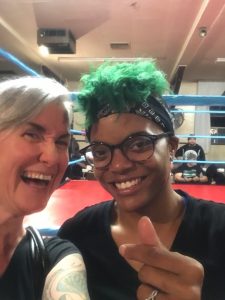
Caption and photo from Christa Faust: Here’s a goofy-ass photo of me (on the left) having a cheesy fan girl moment with Big Swole at a local show a few years back.
Faust: In all my work, I try to give voice to people who so often live and die unheard in this society. People who exist to entertain and be forgotten. The kind of characters who usually become victims in crime novels that allow straight white men to feel feelings and prove their mettle without ever having to see that victim as a real person.
It’s sometimes easier to get readers to think about their own unconscious biases and the ways they benefit from systemic inequality by using a fantasy framework like aliens or monsters. Or masked wrestlers.
Slam: It’s mentioned in the introduction of the book that there are plans to make Hoodtown into a movie, what stage is everything at?
Faust: It’s hard for those who are not in the industry to understand what this means but you’ll often hear the phrase “development hell.” It’s the slowness of the process, the waiting for an impossible number of factors to align, you blink and it’s been 15 years of working away on it but cameras are nowhere near rolling. Yes, it’s happening, but it won’t happen until it happens. It’s really impossible to say.
Slam: Have you ever thought about writing a sequel for Hoodtown or turning it into a series of books?
Faust: The publisher and I thought about an anthology follow up with multiple authors writing stories set in that world, but real life and other opportunities got in the way. I may find my way back around to it or something like it someday, but for now I’m working full time in comics.
Slam: What was it like working with the illustrator Rafael Navarro?
Faust: It was great to work with someone I didn’t have to explain it all to – he knew lucha, the builds, mask design, how thick a luchadora actually is and the noir aesthetic. I also love the way he gives heft to masks, so that they read as thick, tactile fabric not just colorful designs on a smooth head.
Slam: Are you a big reader? I read you collect vintage paperbacks.
Faust: Yes! I’m also a sucker for classic pulp cover art and have plenty of terrible novels with great covers in my collection. When it comes to the actual words I’m a fan of the Shell Scott novels by Richard Prather, because I love the zany sense of humor and the fact that the hero doesn’t take himself too seriously. Also love the “Shakespeare of Sleaze” Orrie Hitt! I’m currently reading and loving Bath Haus by PJ Vernon.
Slam: I also read you are a film noir enthusiast, what are some of your favorite movies?
Faust: Oh man, there are so many. Caged. Act of Violence. Sunset Boulevard. I could give you a huge list, but for the sake of staying on topic let me recommend Night and the City. It’s my all time favorite and it’s about wrestling!
Slam: What are you working on next? Anything wrestling related?
Faust: Nothing directly wrestling related at the moment though as I mentioned above, I’m working on a novel set in the world of rough stock rodeo. Like wrestling, it’s another niche physical trade that’s got these powerful family dynasties and runs deep in the DNA of the participants. It’s huge within its own community but unknown outside the silo.
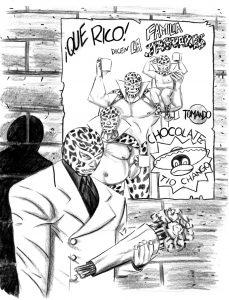
Hoodtown’s El Jaguar de Juarez. Caption from the book: The juxtaposition of suit-and-mask in contrast with the same masks as ring gear instantly illustrates the hood is life and life is spent in the hood. The Jaguar mask and heroic identity are sacred and unchanging, and for generation has been the clan’s bread-and-butter both in the ring and in myriad business ventures out. Illustration by Rafael Navarro.
I’ve also been writing comics for AWA (Artists, Writers & Artisans) which include Bad Mother, about a suburban mom who takes on a drug queenpin, and Redemption, a queer dystopian western set in the near future.
Slam: Is there anything you want to add/anything I missed?
Faust: Readers who liked Hoodtown should definitely check out Rencor: Life in Grudge City by Matt Wallace and Keith Rainville. Also Raf Navarro is working on new Sonambulo and a new edition of his sold out original graphic novel as we speak.
This interview has been edited for length and clarity.
RELATED LINKS
- Buy Hoodtown from Amazon.ca or Amazon.com
- Christa Faust: Website and Twitter
- From Parts Unknown: Website, Twitter, Facebook and Instagram
- SlamWrestling Master Book List
